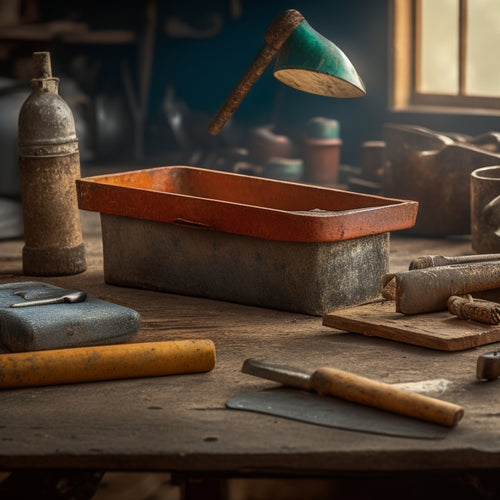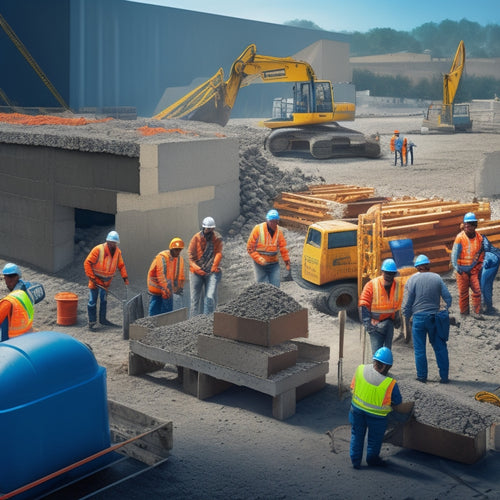
Essential Tools for Cutting Concrete Blocks at Home
Share
You'll need to gear up with essential tools to cut concrete blocks safely and efficiently at home. Start with safety gear like protective eyewear, dust masks, and gloves to prevent injuries. Then, choose from handheld cutting tools like block splitting tools, masonry saws, and hammers, or opt for power saws like circular or reciprocating saws with diamond-coated blades. Additionally, consider block splitting and breaking tools, dust control and cleanup tools, measuring and marking tools, and specialized block cutting accessories. With the right tools, you'll be well-equipped to tackle your project; explore the specific features and benefits of each tool to optimize your cutting process.
Key Takeaways
• Safety gear, including protective eyewear, dust masks, and gloves, is essential for preventing injuries when cutting concrete blocks at home.
• Handheld cutting tools, such as block splitting tools, masonry saws, and hammers, are necessary for control and precision in small-scale projects.
• Power saws, including circular saws and reciprocating saws, are required for making straight cuts and curves, with diamond-coated blades preferred for smooth cuts.
• Dust control and cleanup tools, including dust collection systems and high-quality dust collectors, are crucial for containing dust and maintaining a safe workspace.
• Measuring and marking tools, such as measuring tapes, chalk lines, and squares, are necessary for making precise cuts and ensuring a professional finish.
Safety Gear for Block Cutting
You'll need to wear essential safety gear when cutting concrete blocks to prevent injuries from flying debris, dust, and saw kickback. This gear is vital to protect yourself from the hazards associated with block cutting.
First and foremost, don protective eyewear with shatter-resistant lenses to shield your eyes from debris and dust. Make sure the eyewear fits snugly and doesn't obstruct your vision.
Next, invest in a dust mask or respirator to prevent inhaling concrete dust, which can cause respiratory problems.
Don't forget to wear earplugs or earmuffs for noise reduction, as block cutting can generate loud, prolonged sounds that can damage your hearing.
Additionally, wear gloves to improve grip and prevent blisters, as well as a long-sleeved shirt and pants to protect your skin from cuts and abrasions.
Finally, wear steel-toed boots or shoes with good traction to prevent slips and falls.
Handheld Cutting Tools for Blocks
When you're working with concrete blocks, you need handheld cutting tools that can handle the task efficiently.
You'll want to evaluate block splitting options that provide control and precision, as well as cutting edge technology that makes the job easier.
From portable power tools to specialized saws, you'll find the right tool for the job.
Block Splitting Options
Split concrete blocks efficiently with handheld cutting tools designed specifically for block splitting, which offer a convenient and cost-effective way to cut blocks to size. These tools are ideal for small-scale projects, allowing you to achieve precise cuts without breaking the bank.
When it comes to block splitting techniques, you have several options to choose from. Here are a few popular ones:
| Tool | Description |
|---|---|
| Block Splitter | A manual or hydraulic tool that applies pressure to split the block |
| Masonry Saw | A circular saw designed for cutting through masonry materials |
| Hammer and Chisel | A traditional method that requires more physical effort |
| Block Cutting Machine | A specialized machine that uses a rotating blade to cut blocks |
Block splitting machines are also available for larger projects or frequent use. These machines can greatly reduce the time and effort required for block splitting, making them a worthwhile investment for professionals or serious DIYers. By choosing the right tool for your block splitting needs, you can guarantee accurate cuts and a successful project outcome.
Cutting Edge Technology
For precise cuts and maximum control, turn to handheld cutting tools that harness cutting-edge technology, designed to make quick work of cutting concrete blocks to size.
These innovative tools are engineered to provide you with the accuracy and finesse you need to achieve professional-looking results. When you're working with concrete blocks, you want a tool that can handle the tough job without compromising on precision. That's where cutting technology comes in.
Handheld cutting tools, such as diamond-coated blades and carbide-tipped saws, utilize advanced materials and designs to efficiently cut through concrete blocks. With these tools, you'll experience reduced fatigue, increased speed, and improved accuracy.
Whether you're a DIY enthusiast or a seasoned contractor, these handheld cutting tools will give you the edge you need to tackle even the most demanding projects. By investing in cutting-edge technology, you'll be able to complete your projects more efficiently, saving you time and effort in the long run.
Portable Power Tools
You'll find that portable power tools, such as rotary hammers and reciprocating saws, are vital handheld cutting tools for blocks, offering unparalleled versatility and convenience on the job site.
These tools are designed to make precise cuts in concrete blocks, and their compact size allows for easy maneuverability in tight spaces. Cordless saws, in particular, provide greater flexibility and reduced fatigue, making them ideal for extended projects.
When choosing a portable power tool, consider the type of block you'll be cutting, as well as the tool's power output and blade type.
Regular tool maintenance is essential to guarantee peak performance and extend the tool's lifespan. This includes cleaning the tool regularly, checking and replacing worn blades, and storing it in a dry, secure location.
Additionally, make sure to follow the manufacturer's guidelines for maintenance and repair. By investing in a high-quality portable power tool and following proper maintenance procedures, you'll be able to achieve professional-grade results on your concrete block-cutting projects.
Power Saws for Concrete Blocks
When you're preparing to cut concrete blocks with a power saw, you'll need to select the right tool for the job and pair it with the best saw blade.
You'll want to take into account factors like the saw's power output, blade speed, and durability to guarantee clean cuts and minimize wear and tear.
Choosing the Right Saw
Selecting the right saw for cutting concrete blocks is essential, as it directly impacts the quality of your cuts, your safety, and the overall efficiency of your project.
You'll need to evaluate the type of saw that best suits your needs. There are two primary saw types to choose from: circular saws and reciprocating saws. Circular saws are ideal for making straight cuts, while reciprocating saws are better suited for curved or irregular cuts.
When choosing a saw, you'll also need to assess the blade material. Diamond-coated blades are the most popular choice for cutting concrete blocks, as they provide a smooth, consistent cut and last longer than other blade materials. However, you may also opt for abrasive blades, which are less expensive but wear out faster.
Additionally, review the power source: cordless saws offer greater portability, while corded saws provide more consistent power.
Saw Blade Selection Tips
To guarantee ideal performance and extend the lifespan of your saw, it's crucial to choose the right blade for cutting concrete blocks, as the wrong one can lead to poor cut quality, increased wear, and even safety risks.
When selecting a saw blade, consider the blade materials. Diamond-coated blades are ideal for cutting concrete blocks, as they provide superior cutting performance and durability. You can also opt for abrasive blades, which are more affordable but may require more maintenance.
Your cutting techniques also play a significant role in blade selection. If you're using a push saw, look for blades with a higher tooth count for smoother cuts. For circular saws, choose blades with a lower tooth count for faster cutting.
Additionally, consider the blade's arbor size, kerf, and maximum RPM to guarantee compatibility with your saw.
Block Splitting and Breaking Tools
You'll frequently need block splitting and breaking tools to efficiently cut concrete blocks into smaller, more manageable pieces. When working with concrete blocks, you'll often encounter situations where you need to split or break them to fit specific dimensions or shapes. Having the right tools for block splitting and breaking techniques can make a significant difference in the quality and efficiency of your work.
To achieve precise control over block splitting and breaking, consider the following tools:
| Tool | Description | Breaking Method |
|---|---|---|
| Block Splitter | A handheld or pneumatic tool that applies pressure to split blocks | Wedge and fracture |
| Breaker Bar | A long, heavy bar used to apply force and break blocks | Impact and shatter |
| Chisel Set | A set of handheld chisels for breaking and shaping blocks | Wedge and chip |
| Jackhammer | A powerful pneumatic tool for heavy-duty block breaking | Vibration and shatter |
| Drill and Bit | A drill with a specialized bit for drilling holes and breaking blocks | Rotation and fracture |
These tools will help you master various block splitting techniques and breaking methods, ensuring you can tackle any concrete block cutting project with confidence.
Dust Control and Cleanup Tools
Cutting concrete blocks generates massive amounts of dust and debris, which is why it's crucial to have the right dust control and cleanup tools on hand to minimize mess and maximize safety.
When you're working with concrete, you'll need a reliable dust collection system to contain the dust and prevent it from spreading throughout your workspace. Invest in a high-quality dust collector or vacuum specifically designed for concrete dust, and make sure it's equipped with a HEPA filter to capture 99.97% of particles as small as 0.3 microns.
In addition to dust collection, you'll need effective cleanup methods to remove debris and dust residue from your tools and workspace. A stiff-bristled broom and a dustpan are must-haves for sweeping up larger debris, while a handheld vacuum or blower can help remove finer dust particles.
Don't forget to wear protective gear, including a dust mask, safety glasses, and gloves, to prevent exposure to airborne dust and debris.
Measuring and Marking Tools Needed
Accurate measurements and precise markings are essential when working with concrete blocks, as they guarantee a clean, professional-looking finish and minimize waste. To guarantee accuracy, you'll need the right measuring and marking tools. Here are some essentials to add to your toolkit:
-
Measuring Tape: A sturdy, 25-foot measuring tape will help you take precise measurements of your blocks and walls. Look for one with a rugged design and clear markings.
-
Chalk Line: A chalk line is perfect for creating straight lines on your blocks. Simply snap the line to create a temporary mark that's easy to see and erase.
-
Square: A square guarantees your blocks are properly aligned and helps you make precise cuts. Choose a durable, heavy-duty square that can withstand the demands of your project.
With these measuring and marking tools, you'll be able to make accurate cuts and achieve a professional-looking finish.
Specialized Block Cutting Accessories
A set of specialized block cutting accessories complements your toolkit, providing the necessary leverage and control to make precise cuts in concrete blocks. These accessories are designed to simplify the cutting process, ensuring accurate results and minimizing errors.
One essential accessory is a block cutting jig, which helps you achieve straight cuts and precise angles. This jig can be adjusted to accommodate different block sizes and shapes, making it a versatile addition to your toolkit.
Another vital accessory is a set of concrete block chisels. These chisels are specifically designed for breaking and shaping concrete blocks, allowing you to remove excess material and create clean edges. They come in various sizes and shapes, each suited for specific tasks, such as splitting blocks or creating decorative edges.
Frequently Asked Questions
Can I Use a Regular Drill to Cut Through Concrete Blocks?
You're wondering if you can use a regular drill to cut through concrete blocks. The answer is, it's not recommended.
Regular drills lack the power and speed to efficiently cut through concrete.
You'll need a drill specifically designed for masonry, such as a hammer drill or rotary hammer, which use specialized cutting techniques and bits to tackle tough materials like concrete.
Do I Need to Seal the Cut Edges of Concrete Blocks?
Did you know that over 70% of structural damage in concrete buildings is caused by water seepage?
When you cut concrete blocks, it's essential you seal the cut edges to prevent moisture from seeping in.
You'll need to apply a suitable sealant using various sealing techniques, ensuring moisture protection.
This step is critical, as it prevents water from penetrating the block's core, reducing the risk of structural damage and prolonging the lifespan of your construction project.
Can I Cut Concrete Blocks Underwater to Reduce Dust?
You're thinking of cutting concrete blocks underwater to reduce dust, but can you?
Technically, yes, underwater cutting is possible, and it's an effective way to minimize dust creation. The water absorbs the dust, preventing it from becoming airborne.
However, this method requires specialized equipment and training, so it mightn't be the most practical solution for a DIY project.
Are There Any Eco-Friendly Alternatives to Concrete Blocks?
You're thinking of cutting concrete blocks underwater to reduce dust, but have you considered ditching them altogether?
Ironically, the very material you're trying to cut is a significant contributor to environmental degradation.
Fortunately, there are eco-friendly alternatives!
You can opt for sustainable materials like recycled glass, bamboo, or low-carbon cement.
Embracing green construction methods not only reduces your carbon footprint but also creates a healthier environment for the people you're serving.
Can I Use a Tile Saw to Cut Concrete Blocks?
You're wondering if a tile saw can cut concrete blocks? While it's technically possible, it's not the most efficient or recommended approach.
Tile saw blades aren't designed for concrete, and they'll wear down quickly. Additionally, the cutting techniques required for concrete blocks are quite different from those for tile.
You'll need a saw specifically designed for concrete, like a masonry saw or a circular saw with a diamond blade, to get the job done safely and effectively.
Conclusion
You've now got the essential tools for cutting concrete blocks at home. With these tools, you'll be able to tackle any block-cutting project with confidence.
Did you know that the average American uses over 600 pounds of concrete per year? That's a lot of blocks!
With the right tools and techniques, you'll be able to precision-cut your way through even the toughest concrete projects, just like a pro.
Related Posts
-

Smart Guide to Buying Used Concrete Hand Tools
You're about to buy used concrete hand tools, and you need to get it right. Dedicate time to identify the tools you n...
-

7 Best Tools for Concrete Block Construction
You'll need a solid foundation, precise cutting, and seamless finishing to guarantee your concrete block construction...
-

Why You Need These Concrete Overlay Tools
When tackling a concrete overlay project, you need the right tools to achieve a flawless finish and avoid costly mist...


